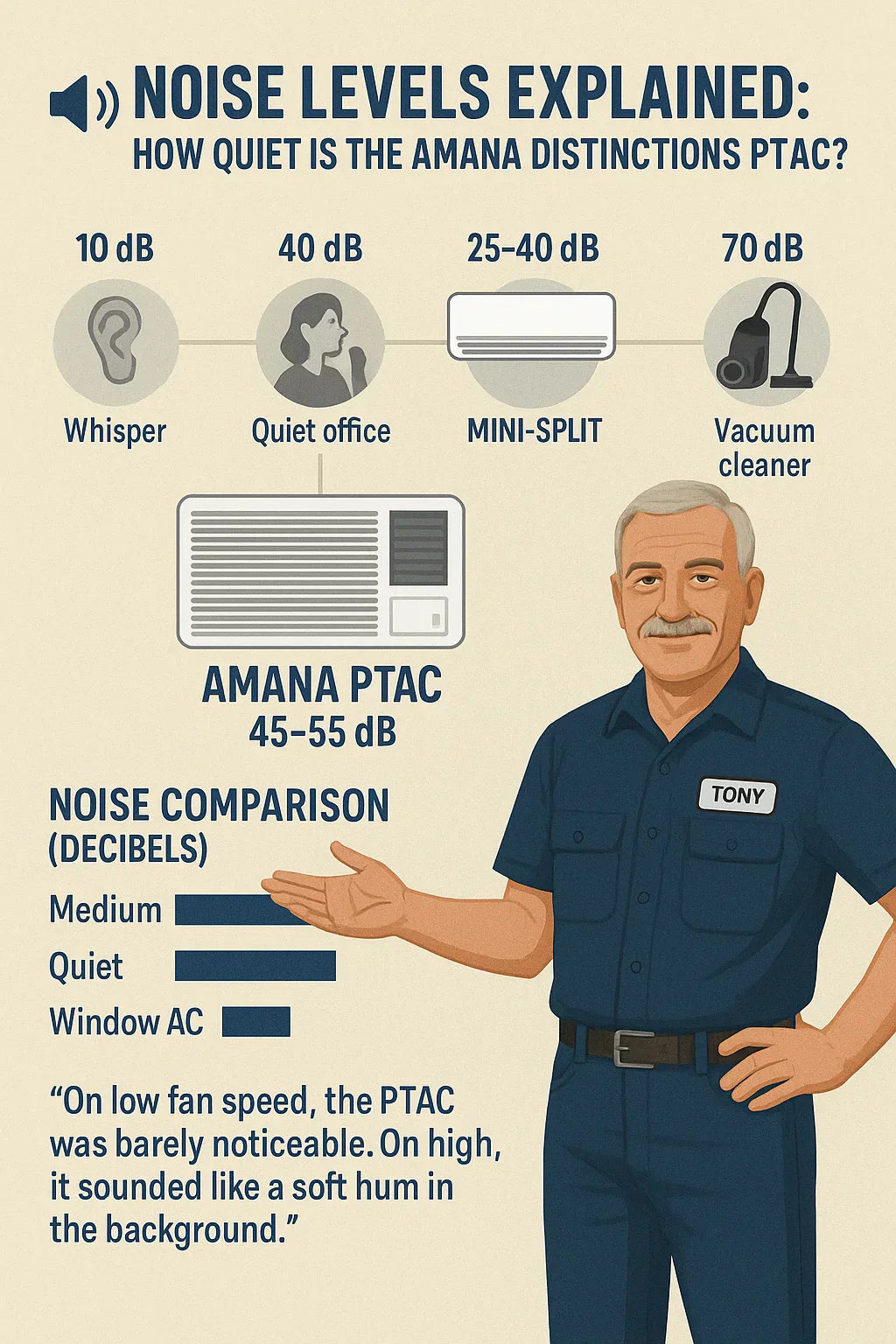When Tony replaced the old rattling window unit in his guest apartment, noise was one of his biggest concerns. His guests often complained about not being able to sleep with the AC roaring through the night.
The solution he landed on was the Amana Distinctions 12,000 BTU PTAC Heat Pump with 3.5 kW Electric Backup—a system commonly used in hotels for its balance of performance, efficiency, and acceptable noise levels.
But just how quiet is it? And how does it compare to mini splits or window ACs? In this guide, Tony explains everything you need to know about PTAC noise levels, real-world decibel ratings, and whether this Amana PTAC is right for your space.
🎧 Understanding PTAC Noise Levels
Before diving into specifics, it helps to understand how noise is measured.
-
Noise is measured in decibels (dB), a logarithmic scale.
-
A 10 dB increase equals double the perceived loudness.
👉 Everyday sound references:
-
25–30 dB = whisper
-
40–50 dB = quiet conversation
-
55–60 dB = office background noise
-
70+ dB = vacuum cleaner
That means the difference between a 45 dB PTAC and a 60 dB window AC can feel huge when you’re trying to sleep.
Reference: CDC – Noise and Hearing Loss Prevention.
🔍 Amana Distinctions PTAC Noise Performance
The Amana Distinctions 12,000 BTU PTAC falls right in the middle of the comfort scale:
-
Low fan speed: ~45 dB (like a quiet library).
-
High fan speed: ~52–55 dB (similar to background office chatter).
-
Compressor cycling: Noticeable when it kicks on, but not disruptive.
👉 Tony’s Real-World Test:
“On low speed, I barely noticed it while watching TV. On high, it was background noise but still way better than the old window unit that rattled the glass.”
Compared to his old system, the Amana PTAC felt like a low hum instead of a roar.
Reference: Consumer Reports – Air Conditioner Noise Tests.
📊 Noise Comparison: PTAC vs. Mini Split vs. Window Unit
Tony compared three systems side by side:
| System | Typical Noise (dB) | Real-World Feel | Best Use |
|---|---|---|---|
| Mini Split | 25–35 dB | Whisper-quiet | Bedrooms, offices |
| PTAC (Amana Distinctions) | 45–55 dB | Soft hum | Apartments, guest suites |
| Window Unit | 55–65 dB | Loud, disruptive | Short-term use, rentals |
👉 According to Energy.gov, PTACs fall between mini splits and window units in terms of noise—making them a solid middle-ground solution.
🛠️ Factors That Affect PTAC Noise
Noise levels aren’t just about the unit itself—installation and maintenance matter too.
1. 🔄 Fan Speed
-
Low = quieter but less airflow.
-
High = louder, better for quick cooling.
2. 🧹 Maintenance
-
Dirty filters force the fan to work harder.
-
Dust buildup on coils increases humming.
3. 🧱 Wall Insulation
-
Poorly sealed sleeves allow vibrations and sound leaks.
-
Proper caulking reduces noise transfer indoors.
4. ⚡ Age of the Unit
-
Older compressors get louder over time.
-
New Amana models are designed with rotary compressors that reduce vibration.
🤫 Tips for Reducing PTAC Noise
Tony learned some tricks to make his PTAC even quieter:
-
Run on Low Fan Speed Overnight → ideal for bedrooms.
-
Clean Filters Monthly → keeps airflow smooth.
-
Vacuum Coils Twice a Year → reduces compressor strain.
-
Seal the Wall Sleeve → prevents vibration rattles.
-
Install a Noise-Dampening Sleeve → available as an accessory.
👉 Reference: Amana PTAC Maintenance Guidelines.
🛌 Is the Amana PTAC Quiet Enough for Bedrooms?
This was Tony’s biggest question—would guests sleep well with the unit running?
-
On low fan, most guests reported the sound as “like white noise.”
-
On high fan, a few noticed it but still found it manageable.
-
Compared to a window AC, it was much quieter.
For light sleepers, a mini split may be the better choice. But for Tony’s guest suite, the Amana PTAC struck the perfect balance: affordable, efficient, and quiet enough.
Reference: ASHRAE – Recommended Indoor Sound Levels.
📐 Why Hotels Choose PTACs Despite Noise
Ever wonder why so many hotels use PTACs? It’s because they balance:
-
Cost efficiency (cheaper than mini splits for multiple rooms).
-
Reliability (self-contained, easy to replace).
-
Noise tolerance (guests usually accept a soft hum as “background sound”).
Hotels like Marriott, Hilton, and Holiday Inn often install Amana PTACs specifically because they meet acceptable sound ranges for guest comfort.
💡 Tony’s Case Study: Living with the Amana Distinctions PTAC
Tony’s installation experience:
-
Room Size: 500 sq. ft. guest apartment.
-
Noise Test: 45 dB on low, 53 dB on high.
-
Guest Feedback: “Sounds like a quiet fan—didn’t disturb sleep.”
-
His Takeaway: “Not silent like a mini split, but way better than the old window AC. The noise blends into the background.”
🎯 Final Verdict: How Quiet Is the Amana PTAC?
✅ Quieter than a window AC
✅ Acceptable for guest rooms and living spaces
✅ Noticeable but not disruptive in bedrooms
❌ Not as silent as a ductless mini split
Tony’s advice:
“If you’re upgrading from a window unit, the Amana PTAC will feel whisper-quiet. If you’re ultra-sensitive to noise, go for a mini split. For most folks, it’s just a comfortable hum in the background.”
In the next topic we will know more about: Energy Efficiency & Operating Costs: What to Expect from a 12,000 BTU Amana PTAC







